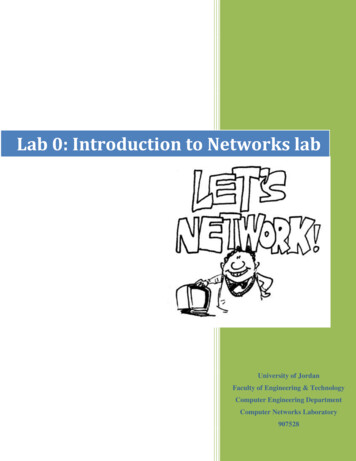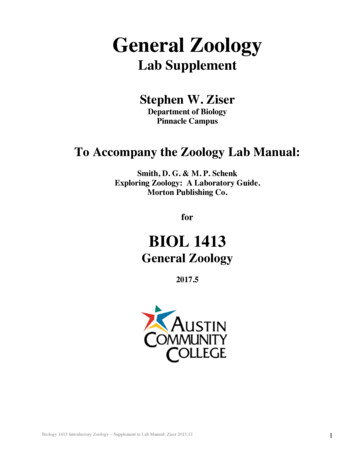
Transcription
Lab 0: Introduction to Networks labUniversity of JordanFaculty of Engineering & TechnologyComputer Engineering DepartmentComputer Networks Laboratory907528
1Lab 0: Introduction to Networks labIntroduction to NetworkingBy themselves, computers are powerful tools. When they are connected in a network, theybecome even more powerful because the functions and tools that each computer provides canbe shared with other computers.Network is a small group of computers that share information, or they can be very complex,spanning large geographical areas that provide its users with unique capabilities, above andbeyond what the individual machines and their software applications can provide.The goal of any computer network is to allow multiple computers to communicate. The type ofcommunication can be as varied as the type of conversations you might have throughout thecourse of a day. For example, the communication might be a download of an MP3 audio file foryour MP3 player; using a web browser to check your instructor’s web page to see whatassignments and tests might be coming up; checking the latest sports scores; using an instantmessaging service, such as Yahoo Messenger, to send text messages to a friend; or writing an email and sending it to a business associate.Networks Advantages and Disadvantages:-Network Hardware, Software and SetupCosts.-Hardware and Software Management &Administration Costs.-Undesirable Sharing.-Illegal or Undesirable Behavior.-Data Security Concerns.-Connectivity and Communication.-Data SharingHardware Sharing.-Internet Access.-Data Security and Management.-Performance Enhancement and Balancing.-Entertainment.
2Lab 0: Introduction to Networks labNetwork Types:Different types of networks are distinguished based on their size (in terms of the number ofmachines), their data transfer speed, and their reach. There are usually said to be two categoriesof networks: Local Area Network (LAN)is limited to a specific area, usually an office, and cannotextend beyond the boundaries of a single building. The first LANs were limited to a range(from a central point to the most distant computer) of 185 meters (about 600 feet) and no morethan 30 computers. Today’s technology allows a larger LAN, but practical administrationlimitations require dividing it into small, logical areas called workgroups.A workgroup is a collection of individuals who share the same files and databases over theLAN. Wide Area Network (WAN)If you have ever connected to the Internet, you have usedthe largest WAN on the planet. A WAN is any network that crosses metropolitan, regional, ornational boundaries. Most networking professionals define a WAN as any network that usesrouters and public network links. The Internet fits both definitions.
3Lab 0: Introduction to Networks labDefinition:Speed:Data transferrates:Example:Components:LANLAN (Local Area Network) is acomputer network covering asmall geographic area, like ahome, office, schools, or groupof buildings.High speed(1000mbps)High data transfer rate.Network in an organization.Layer 2 devices like switches,bridges. layer1 devices likehubs , repeatersData Transmission Experiences fewer datatransmission errors.Error:Ownership:Typically owned, controlled,and managed by a single personor organization.Set-up an extra devices on thenetwork, it is not veryexpensive.Maintenance costs: Covers a relatively smallgeographical area, LAN iseasier to maintain atrelatively low costs.Have aGeographicalsmall geographical range.Spread:Set-up costs:Bandwidth:High bandwidth is available fortransmission.WANWAN (Wide Area Network) is acomputer network that covers abroad area or any network whosecommunications links crossmetropolitan, regional, or nationalboundaries over a long distance.Less speed(150mbps)Lower data transfer rate ascompared to LANs.The Internet.Layers 3 devices Routers,Switches and Technology specificdevices like ATM or Frame-relaySwitches.Experiences more datatransmission errors as compared toLAN.WANs (like the Internet) are notowned by any one organizationbut rather exist under collectivedistributed ownership andmanagement over long distances.Networks in remote areas have tobe connected, Set-up costs arehigher.Maintaining WAN is difficultbecause of its wider geographicalcoverage and higher maintenancecosts.Have a large geographical rangegenerally spreading acrossboundaries.Low bandwidth is available fortransmission.The OSI and TCP/IP Networking Models:Models are useful because they help us understand difficult concepts and complicated systems.When it comes to networking, there are several models that are used to explain the roles playedby various technologies, and how they interact. Of these, the most popular and commonly usedis the Open Systems Interconnection (OSI) Reference Model.
4Lab 0: Introduction to Networks labThe OSI model was designed to promote interoperability by creating a guideline for networkdata transmission between computers and components that have different hardware vendors,software, operating systems, and protocols.The idea behind the OSI Reference Model is to provide a framework for both designingnetworking systems and for explaining how they work. The existence of the model makes iteasier for networks to be analyzed, designed, built and rearranged, by allowing them to beconsidered as modular pieces that interact in predictable ways, rather than enormous, complexmonoliths.TCP/IP ModelThe Internet Protocol Suite, popularly known as the TCP/IP model, is a communicationprotocol that is used over the Internet. This model divides the entire networking functions intolayers, where each layer performs a specific function.This model gives a brief idea about the process of data formatting, transmission, and finally thereception. Each of these functions takes place in the layers, as described by the model. TCP/IPis a four-layered structure, with each layer having their individual protocol.
5Lab 0: Introduction to Networks labBoth the TCP/IP and OSI model work in a very similar fashion. But they do havevery subtle differences too. The most apparent difference is the number of layers.TCP/IP is a four-layered structure, while OSI is a seven-layered model.Why Use a Layered Model?By using a layered model, we can categorize the procedures that are necessary to transmit dataacross a network. First, we need to define the term protocol: is a set of guidelines or rules ofcommunication.Layered modeling allows us to: Create a protocol that can be designed and tested in stages, which, in turn, reduces thecomplexity Enhance functionality of the protocol without adversely affecting the other layers Provide multivendor compatibility Allow for easier troubleshooting by locating the specific layer causing the problem
6Lab 0: Introduction to Networks labOSI model divides the network into seven layers and explains the routing of the data fromsource to destination. It is a theoretical model which explains the working of the networks. HerearethedetailsofOSI'ssevenlayers:Application Layer (Layer 7)The Application layer is a buffer between the user interface (what the user uses to performwork) and the network application. This layer responsible for finding a communication partneron the network. Once a partner is found, it is then responsible for ensuring that there issufficient network bandwidth to deliver the data.This layer may also be responsible for synchronizing communicationand providing high level error checking between the two partners.This ensures that the application is either sending or receiving, andthat the data transmitted is the same data received.Typical applications include a client/server application (Telnet), an email application (SMTP), and an application to transfer files usingFTP or HTTP.Presentation Layer (Layer 6)The Presentation layer is responsible for the presentation of data to the Application layer. Thispresentation may take the form of many structures. Data that it receives from the applicationlayer is converted into a suitable format that is recognized by the computer. Perform conversionbetween ASCII and EBCDIC (a different character formatting method used on manymainframes).The Presentation layer must ensure that the application can view the appropriate data when it isreassembled. Graphic files such as PICT, JPEG, TIFF, and GIF, and video and sound files suchas MPEG and Apple’s QuickTime are examples of Presentation layer responsibilities.One final data structure is data encryption. Sometimes, it is vital that we can send data across anetwork without someone being able to view our data, or snoop it.
7Lab 0: Introduction to Networks labSession Layer (Layer 5)The Session layer sets up and terminates communications between the two partners. Thislayerdecides on the method of communication: half-duplex or full-duplex.Full-Duplex vs. Half-Duplex CommunicationsAll network communications (including LAN and WAN communications) can be categorizedas Half-duplex or full-duplex. With half-duplex, communications happen in both directions, butin only one direction at a time. When two computers communicate using half-duplex, onecomputer sends a signal and the other receives; then, at some point, they switch sending andreceiving roles.Full-duplex, on the other hand, allows communication in both directions simultaneously. Bothstations can send and receive signals at the same time. Full-duplex communications are similarto a telephone call, in which both people can talk simultaneously.
8Lab 0: Introduction to Networks labTransport Layer (Layer 4)This layer provides end-to-end delivery of data between two nodes. It divides data into differentpackets before transmitting it. On receipt of these packets, the data is reassembled andforwarded to the next layer. If the data is lost in transmission or has errors, then this layerrecovers the lost data and transmits the same.Transport layer add port number and sequence number to assemble and distinguish betweenmultiple applications segments received at a device; this also allows data to be multiplexed onthe line.Multiplexing is the method of combining data from the upper layers and sending them throughthe same data stream. This allows more than one application to communicate with thecommunication partner at the same time. When the data reaches the remote partner, theTransport layer then disassembles the segment and passes the correct data to each of thereceiving applications.Network Layer (Layer 3)The main function of this layer is routing data has to its intended destination on the network aslong as there is a physical network connection. The device that allows us to accomplish thisspectacular feat is the router, sometimes referred to as a Layer 3 device. While doing so, it problems,etc.In order for the router to succeed in this endeavor, it must be able to identify the source segmentand the final destination segment. This is done through network addresses, also called logicaladdresses.When a router receives data, it examines the Layer 3 data to determine the destination networkaddress. It then looks up the address in a table that tells it which route to use to get the data toits final destination. It places the data on the proper connection, there by routing the packetfrom one segment to another. The data may need to travel through many routers beforereaching its destination host. Each router in the path would perform the same lookup in itstable.
9Lab 0: Introduction to Networks labOverview of IP AddressesTCP/IP requires that each interface on a TCP/IP network have its own unique IP address. Thereare two addressing schemes for TCP/IP: IPv4 and IPv6.IPv4An IPv4 address is a 32-bit number, usually represented as a four-part decimal number witheach of the four parts separated by a decimal point. In the IPv4 address, each individual byte, oroctet as it is sometimes called, can have a value in the range of 0 through 255.The way these addresses are used varies according to the class of the network, so all you cansay with certainty is that the 32-bit IPv4 address is divided in some way to create an identifierfor the network, which all hosts on that network share, and an identifier for each host, which isunique among all hosts on that network. In general, though, the higher-order bits of the addressmake up the network part of the address and the rest constitutes the host part of the address. Inaddition, the host part of the address can be divided further to allow for a sub network address.IPv6IPv6 was originally designed because the number of available unregistered IPv4 addresses wasrunning low. Because IPv6 uses a 128-bit addressing scheme, it has more than 79 octilliontimes as many available addresses as IPv4. Also, instead of representing the binary digits asdecimal digits, IPv6 uses eight sets of four hexadecimal digits, ketsAt the Network layer, data coming from upper-layer protocols are divided into logical chunkscalled packets. A packet is a unit of data transmission. The size and format of these packetsdepend on the Network layer protocol in use. In other words, IP packets differ greatly from IPXpackets and Apple-Talk DDP packets, and the three are not compatible.
10Lab 0: Introduction to Networks labData Link Layer (Layer 2)The main function of this layer is to convert the data packets received from the upper layer intoframes, and route the same to the physical layer. Error detection and correction is done at thislayer, thus making it a reliable layer in the model. It establishes a logical link between the nodesand transmits frames sequentially.The Data Link layer is split into two sub layers, the Logical Link Control (LLC) and the MediaAccess Control (MAC). MAC sub layer is closer to the Physical layer.The MAC sub layer defines a physical address, called a MAC address or hardware address,which is unique to each individual network interface. This allows a way to uniquely identifyeach network interface on a network, even if the network interfaces are on the same computer.More importantly, though, the MAC address can be used in any network that supports thechosen network interface.
11Lab 0: Introduction to Networks labWhat Is a MAC Address?The MAC address is a unique value associated with a network adapter. MAC addressesare also known as hardware addresses or physical addresses. They uniquely identify anadapter on a LAN.MAC addresses are 12-digit hexadecimal numbers (48 bits in length). By convention,MAC addresses are usually written as the following format:MM:MM:MM:SS:SS:SS or MM-MM-MM-SS-SS-SSThe first half of a MAC address contains the ID number of the adapter manufacturer.These IDs are regulated by an Internet standards body (see sidebar). The second half of aMAC address represents the serial number assigned to the adapter by the manufacturer.MAC addresses function at the data link layer (layer 2). They allow computers touniquely identify themselves on a network at this relatively low level.MAC layer on the receiving computer will take the bits from the Physical layer and put them inorder into a frame. It will also do a CRC (Cyclic Redundancy Check) to determine if there areany errors in the frame.It will check the destination hardware address to determine if the data is meant for it, or if itshould be dropped or sent on to the next machine. If the data is meant for the current computer,it will pass it to the LLC layer.The LLC layer is the buffer between the software protocols and the hardware protocols. It isresponsible for taking the data from the Network layer and sending it to the MAC layer. Thisallows the software protocols to run on any type of network architecture.
12Lab 0: Introduction to Networks labFramesAt the Data Link layer, data coming from upper-layer protocols are divided into logical chunkscalled frames. A frame is a unit of data transmission. The size and format of these framesdepend on the transmission technology. In other words, Ethernet frames differ greatly fromToken Ring frames and Frame Relay frames, and the three are not compatible.Physical Layer (Layer 1)As the name suggests, this is the layer where the physical connection between two computerstakes place. The data is transmitted via this physical medium to the destination's physical layer.It is responsible for sending data and receiving data across a physical medium.This data is sent in bits, either a 0 or a 1. The data may be transmitted as electrical signals (thatis, positive and negative voltages), audio tones, or light.This layer also defines the Data Terminal Equipment (DTE) and the Data Circuit-TerminatingEquipment (DCE). The DTE is often accessed through a modem or a Channel ServiceUnit/Data Service Unit (CSU/DSU) connected to a PC or a router. The carrier of the WANsignal provides the DCE equipment. A typical device would be a packet switch, which isresponsible for clocking and switching.Data Encapsulation Using the OSI ModelSince there may be more than one application using more than one communication partnerusing more than one protocol, how does the data get to its destination correctly. This isaccomplished through a process called data encapsulation.
13Lab 0: Introduction to Networks labBasically, it works like this:1.A user is working on an application and decides to save the data to are mote server. Theapplication calls the Application layer to start the process.2.The Application layer takes the data and places some information, called a header, at thebeginning. The header tells the Application layer which user application sent the data.3.The Application layer then sends the data to the Presentation layer, where the dataconversion takes place. The Presentation layer places a header on all of the informationreceived from the Application layer (including the Application layer header). This headeridentifies which protocol in the Application layer to pass it back.4.The Presentation layer then sends the complete message to the Session layer. The Sessionlayer sets up the synchronized communication information to speak with the communicationpartner and appends the information to another header.5.The Session layer then sends the message to the Transport layer, where information isplaced into the header identifying the source and the destination hosts and the method ofconnection (connectionless versus connection-oriented).6.The Transport layer then passes the segment to the Network layer, where the networkaddress for the destination and the source are included in the header.7.The Network layer passes the packet (connection-oriented) or the datagram(connectionless) to the Data Link layer. The Data Link layer then includes the SSAP and theDSAP to identify which Transport protocol to return it to. It also includes the source and thedestination MAC addresses.
14Lab 0: Introduction to Networks lab8.The Data Link layer then passes the frame to the Physical layer for transmitting on thephysical medium as individual bits.9.Finally, the receiving computer receives the bits and reverses the process to get theoriginal data to the source application; in this case, a file server service.Note that since the top three layers have similar functionality, we can typically combine all ofthe data in those layers and simply refer to it as the Protocol Data Unit (PDU). In this Instance,we can substitute the term PDU for the term message.Decapsulation process:Decapsulation is the inverse of the encapsulation process. Encapsulation is the process ofwrapping the data while the Decapsulation process is a process of opening packs. The processwas reversed from the encapsulation process. Encapsulation process starts from the uppermostlayer (Application Layer) to the lowest layer (Physical layer) while the Decapsulation processstarts from the lowest layer (Physical Layer) to the uppermost layer (Application Layer)Although every device on a LAN is connected to every other device, they do not necessarilycommunicate with each other. There are two basic types of LANs, based on the communicationpatterns between the machines: client/server networks and peer-to-peer networks.Client/Server NetworkA client/server network uses a network operating system designed to manage the entire networkfrom a centralized point, which is the server. Clients make requests of the server, and the serverresponds with the information or access to a resource.Every computer has a distinct role: that of either a client or a server. A server is designed toshare its resources among the client computers on the network. Typically, servers are located insecured areas, such as locked closets or data centers (server rooms), because they hold anorganization’s most valuable data and do not have to be accessed by operators on a continuousbasis. The rest of the computers on the network function as clients.
15Lab 0: Introduction to Networks labPeer-to-Peer NetworkIn peer-to-peer networks, the connected computers have no centralized authority. From anauthority viewpoint, all of these computers are equal. In other words, they are peers. If a user ofone computer wants access to a resource on another computer, the security check for accessrights is the responsibility of the computer holding the resource.Each computer in a peer-to-peer network can be both a client that requests resources and aserver that provides resources.Application Layer Services and ProtocolsUnderstanding ServersIn the truest sense, a server does exactly what the name implies: It provides resources to theclients on the network (“serves” them, in other words). Servers are typically powerfulcomputers that run the software that controls and maintains.
16Lab 0: Introduction to Networks labServers are often specialized for a single purpose. This is not to say that a single server can’t domany jobs, but you’ll get better performance if you dedicate a server to a single task. Here aresome examples of servers that are dedicated to a single task: File Server Holds and distributes files. Print Server Controls and manages one or more printers for the network. Proxy Server Performs a function on behalf of other computers. Application Server Hosts a network application. Web Server Holds and delivers web pages and other web content using the HypertextTransfer Protocol (HTTP). Mail Server Hosts and delivers e-mail. It’s the electronic equivalent of a post office. Fax Server Sends and receives faxes for the entire network without the need for paper. Telephony Server Functions as a “smart” answering machine for the network. It canalso perform call center and call-routing functions. Notice that each server type’s name consists of the type of service the server provides(remote access, for example) followed by the word server, which, as you remember, means toserve.Application Layer protocols: Domain Name Service (DNS):DNS is a popular and important naming service based on the client/server model; DNStranslates names into IP addresses. You can use friendly names like www.trainsolutions.com torefer to computers instead of unfriendly IP addresses like 192.168.24.31.There are two parts to a DNS name: the host name (e.g., www) and the domain name (e.g.,trainsolutions.com).Each of these components are separated by a period. Typically, you wouldassign a host name that says what the computer’s function is (e.g., www for a web server).The domain name, on the other hand, is usually the name of the company in which thecomputer resides, or some related name, followed by .com, .edu, .net, or any other top-leveldomain suffix.
17Lab 0: Introduction to Networks lab Dynamic Host Configuration Protocol (DHCP):DHCP used to provide IP configuration information to hosts on boot up. DHCP managesaddressing by leasing the IP information to the hosts. This leasing allows the information to berecovered when not in use and reallocated when needed.The primary reason for using DHCP is to centralize the management of IP addresses. When theDHCP service is used, DHCP scopes include pools of IP addresses that are assigned forautomatic distribution to client computers on an as-needed basis, in the form of leases, whichare periods of time for which the DHCP client may keep the configuration assignment. Clientsattempt to renew their lease at 50 percent of the lease duration. The address pools arecentralized on the DHCP server, allowing all IP addresses on your network to be administeredfrom a single server.It should be apparent that this saves loads of time when changing the IP addresses on yournetwork. Instead of running around to every workstation and server and resetting the IP addressto a new address, you simply reset the IP address pool on the DHCP server. The next time theclient machines are rebooted, they are assigned new addresses.DHCP Information can include: IP address.Subnet mask.Default gateway.Domain name.DNS Server. Simple Network Management Protocol (SNMP):SNMP allows network administrators to collect information about the network. It is acommunications protocol for collecting information about devices on the network, includinghubs, routers, and bridges. Each piece of information to be collected about a device is definedin a Management Information Base (MIB). SNMP uses UDP to send and receive messages onthe network.
18Lab 0: Introduction to Networks lab File Transfer Protocol (FTP):FTP provides a mechanism for single or multiple file transfers between computer systems;when written in lowercase as “ftp,” it is also the name of the client software used to access theFTP server running on the remote host. The FTP package provides all the tools needed to lookat files and directories, change to other directories, and transfer text and binary files from onesystem to another. FTP uses TCP to actually move the files.FTP ServerFTP ClientFTP ClientFTP Server Trivial File Transfer Protocol (TFTP):TFTP is a “stripped down” version of FTP, primarily used to boot diskless workstations and totransfer boot images to and from routers. It uses a reduced feature set (fewer commands and asmaller overall program size). In addition to its reduced size, it also uses UDP instead of TCP,which makes for faster transfers but with no reliability. Simple Mail Transfer Protocol (SMTP):SMTP allows for a simple e-mail service and is responsible for moving messages from one email server to another. Post Office Protocol (POP):POP provides a storage mechanism for incoming mail; the latest version of the standard isknown as POP3. When a client connects to a POP3 server, all the messages addressed to thatclient are downloaded; there is no way to download messages selectively. Once the messagesare downloaded, the user can delete or modify messages without further interaction with theserver. In some locations, POP3 is being replaced by another standard, IMAP.
19Lab 0: Introduction to Networks lab TelnetTelnet is a terminal emulation protocol that provides a remote logon to another host over thenetwork. It allows a user to connect to a remote host over a TCP/IP connection as if they weresitting right at that host. Keystrokes typed into a Telnet program will be transmitted over aTCP/IP network to the host. The visual responses are sent back by the host to the Telnet clientto be displayed.
20Lab 0: Introduction to Networks lab Secure Shell (SSH):SSH used to establish a secure Telnet session over a standard TCP/ IP connection. It is used torun programs on remote systems, log in to other systems, and move files from one system toanother, all while maintaining a strong, encrypted connection. Hypertext Transfer Protocol (HTTP):HTTP is the command and control protocol used to manage communications between a webbrowser and a web server. When you access a web page on the Internet or on a corporateintranet, you see a mixture of text, graphics, and links to other documents or other Internetresources. HTTP is the mechanism that opens the related document when you select a link, nomatter where that document is actually located.HTTP works as a request-response protocol between a client and server. A web browser may bethe client, and an application on a computer that hosts a web site may be the server.Example: A client (browser) submits an HTTP request to the server; then the server returns aresponse to the client. The response contains status information about the request and may alsothe requested content.
21Lab 0: Introduction to Networks labTwo HTTP Request Methods: GET and POSTTwo commonly used methods for a request-response between a client and server are: GET andPOST. GET - Requests data from a specified resource. Its header consists of many parameters. POST - Submits data to be processed to a specified resource Hypertext Transfer Protocol Secure (HTTPS)HTTPS is a secure version of HTTP that provides a variety of security mechanisms to thetransactions between a web browser and the server. HTTPS allows browsers and servers tosign, authenticate, and encrypt an HTTP message.
22Lab 0: Introduction to Networks labTransport layer protocols (TCP/UDP)TCP stands for Transmission Control Protocol, and UDP is the abbreviation for User DatagramProtocol. Both pertain to data transmissions on the Internet, but they work very differently.Acronym ransmission Control ProtocolAs a message makes its wayacross the internet from onecomputer to another. This isconnection based.TCP is used in case of non-timecritical applications.HTTP, HTTPs, FTP, SMTPTelnet etc.data TCP rearranges data packetsin the order specified.Speed of transfer:Error Checking:The speed for TCP is slower thanUDP.There is absolute guarantee thatthe data transferred remainsintact and arrives in the sameorder in which it was sent.TCP header size is 20 bytesData is read as a byte stream,no indications are transmitted tosignal message(segment)boundaries.TCP does
7 Lab 0: Introduction to Networks lab Session Layer (Layer 5) The Session layer sets up and terminates communications between the two partners. Thislayer decides on the method of communication: half-duplex or full-duplex. Full-Duplex vs. Half-Duplex Communications










